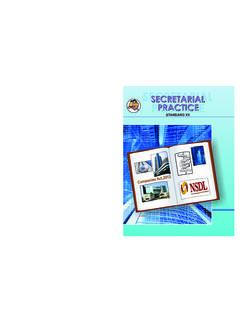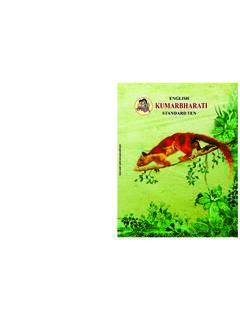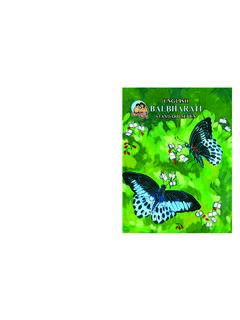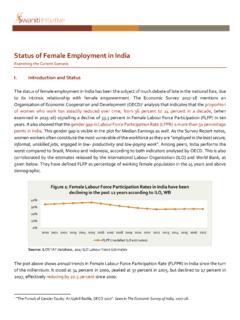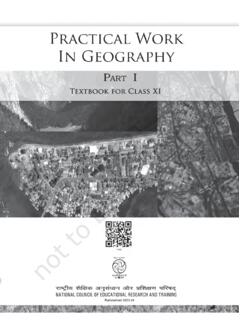Transcription of ENVIRONMENT EDUACATION AND WATER SECURITY
1 ENVIRONMENT EDUACATION AND WATER SECURITY2019 Maharashtra State Bureau of Textbook Production andCurriculum Research, Pune. The Coordination Committee formed by GR No. Abhyas - 2116/( ) SD - 4 Dated has given approval to prescribe this textbook in its meeting held on and it has been decided to implement it from academic year ELEVEND ownload DIKSHA App on your smartphone. If you scan the on this page of your textbook, you will be able to access full text. If you scan the provided, you will be able to access audio-visual study material relevant to each lesson, provided as teaching and learning AND WATER SECURITYThe Maharashtra State Bureau of Textbook Production and Curriculum Research reserves all rights relating to the book.
2 No part of this book should be reproduced without the written permission of the Director, Maharashtra State Bureau of Textbook Production and Curriculum Research, Balbharati , Senapati Bapat Marg, Pune 411004. Maharashtra State Bureau of Textbook Production and Curriculum Research, Pune - 411 Edition :2019 Publisher : Shri Vivek Uttam Gosavi ControllerMaharashtra State Textbook Bureau, Prabhadevi,Mumbai - 400 025 Illustrations : Shri Bhatu Ramdas Bagale Cover : Shri Bhatu Ramdas BagaleCartography : Shri Ravikiran JadhavTranslation Coordination :Shri Ravikiran JadhavSpecial Officer ( ENVIRONMENT )Typesetting : DTP Section, Textbook Bureau, PunePaper : 70 GSM CreamwovePrint Order : Printer : ENVIRONMENT education and WATER SECURITY Subject CommiteeDr.
3 Kranti Dhananjay Yardi, (Chairman)Dr. Bapu Jivanrao Bhosale, MemberMr. Parmeshwar Arunrao Jadhav, MemberMrs. Anita Rajendra Patil, MemberDr. Rajkumar Ramesh Khapekar, MemberShri Ravikiran Jadhav, Member SecretaryEnvironment education and WATER SECURITY Study GroupMr. Shekhar Shankarrao SalunkeDr. Ansari Mohd. Rafique Abdul SattarKu. Jameela Khatoon Shariful HasanDr. Nitin Manohar ValanjuMrs. Jaysheela Mahadev KaradeProductionSachchitanand AphaleChief Production OfficerShri Liladhar AtramProduction OfficerReprint : 2021 The Constitution of IndiaPreamble WE, THE PEOPLE OF INDIA, having solemnly resolved to constitute India into a SOVEREIGN SOCIALIST SECULAR DEMOCRATIC REPUBLIC and to secure to all its citizens: JUSTICE, social, economic and political; LIBERTY of thought, expression, belief, faith and worship; EQUALITY of status and of opportunity; and to promote among them all FRATERNITY assuring the dignity of the individual and the unity and integrity of the Nation.
4 IN OUR CONSTITUENT ASSEMBLY this twenty-sixth day of November, 1949, do HEREBY ADOPT, ENACT AND GIVE TO OURSELVES THIS ANTHEM(Dr. Sunil Magar)DirectorMaharashtra State Bureau of Textbook Production and Curriculum Research, PunePrefaceDear Students/Readers, The Maharashtra State Curriculum Framework 2010 (SCF 2010) has been prepared in accordance to the National Curriculum Framework 2005. The present book is organised according to teaching and learning approaches and materials based on SCF 2010. The Hon ble Supreme Court (SC) has directed that ENVIRONMENT education (EE) to be compulsory at all levels of education . Following the directives given by the SC, EE has been decided to be a separate and compulsory subject at 11th and 12th Maharashtra State has prepared the book which includes major concepts of ENVIRONMENT which shall encourage collaborative learning and group activities to facilitate peer learning.
5 The book has been prepared for constructivist approach and activity based teaching-learning. The contents have been presented in a graded manner to facilitate knowledge building with illustrations relevant to the content of the syllabus. The textbook highlights the measures for protection and care of the ENVIRONMENT , conservation of Biodiversity, Natural resources and management of disasters. The topics are included to facilitate understanding of sustainable development. The interactive processes of social, environmental and economic problems and the ways and means to solve them are presented. This textbook also considers appropriate environmental case studies related to various topics in the book.
6 Teachers are encouraged to emphasize this view and try to apply it during transaction of the syllabus. The curriculum, emphasises student activities as the main vehicle of learning. At the higher secondary stage, to ensure continuation of proactive action towards ENVIRONMENT , the core course is considered compulsory course in a project and theory exam-based evaluation mode. Such approach would help in understanding of practical environmental issues and will also enhance student s motivation and contribution towards solving current problems. Different examplar activities and project work suggested (but not restricted to) in the textbooks provide exposures to the practical environmental issues. The project-based learning would ensure learning to bring forth good, sensitive, rational citizens.
7 A careful planning and preparation can lead to successful implementation of this approach. Expert views and suggestions are included in this book. Hope that the content of this book will help students and teachers understand and act upon responsibly towards ENVIRONMENT . The Maharashtra State Bureau of Textbook Production and Curriculum Research, Pune, looks forward for feedback and suggestions from teachers, parents and other readers. PuneDate : 20 June 2019 Bharatiya Saur Dinank : 30 Jyeshtha 1941 l Develop skills of observation and explore the natural and social ENVIRONMENT , gradually moving from immediate to the wider ENVIRONMENT . l Develop a concrete understanding of integrated perspective of ENVIRONMENT . l Explore, understand, appreciate and value his/her opinion on local and regional environmental issues.
8 L Share the details of the observed objects/events/ phenomenon orally/ written/ drawings/any other ways of choice with reference to the explained/observed scope and importance of ENVIRONMENT . l This produces a deeper understanding of issues related to sustainability at national, state and local levels. l Gain knowledge, discuss and appreciate the efforts of different organizations. l Describe and document the efforts involved in supporting actions that shall positively affect the attitudes to subscribe to the vision and adopt global environmental welfare and eventually develop sensitivity towards concerned environmental issues. l Accepts and takes responsibility in a more refined manner, poses questions and finds answers through reflection, discussion, designing and performing appropriate activities.
9 L Generate awareness, explore, share, narrate the natural and social ENVIRONMENT from lived experiences. l Understand the relationships between natural and social ENVIRONMENT within and beyond classroom through the opportunity providing concrete learning experiences. l Develop various processes/skills through the interaction with the natural and social ENVIRONMENT . l Generate an understanding of the classified structure and related function of ecosystems. l Identify surrroundings based on observable features, similarities and differences in ecosystems, sorts/groups features based on observations. l Observe, relate, share and explain experiences about the dynamics of ecosystem, processes and phenomenon with causes. l Finds an opportunity to apply learnt scientific concepts in day-to-day life.
10 L Relate to the real situations in their surroundings. l Understand the term biodiversity and the levels of 11 ENVIRONMENT education AND WATER SECURITYCOMPETENCY STATEMENT l Understand, get sensitized and be able to explain the values of biodiversity with the help of examples. l Appreciate the variations/ diversity in natural and social ENVIRONMENT and develop a scientific understanding of the variations and the need to respect them. l Obtain information regarding 'India a megadiversity nation'. l Explain the threats of biodiversity and its effects. l Understand the conservation of biodiversity as a social responsibility. l Explore different types of natural resources, appreciate the interdependence and interrelatedness of all living things and life support systems.
